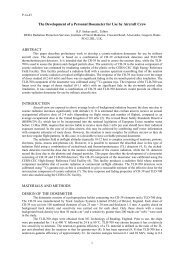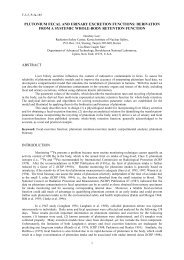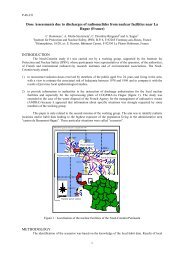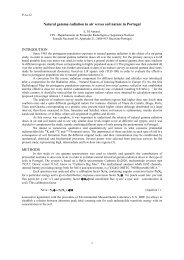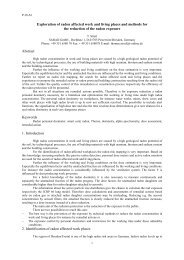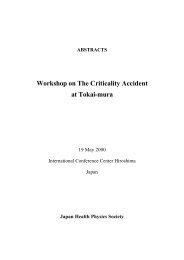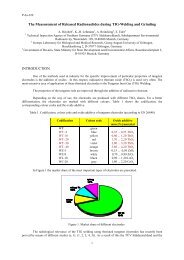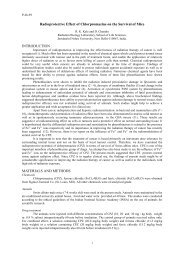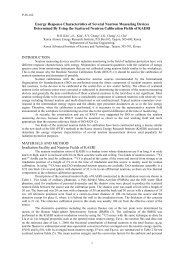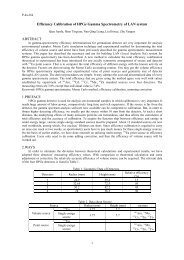Change in the Sensitivity of CR-39 for Alpha-Tracks after Storage at ...
Change in the Sensitivity of CR-39 for Alpha-Tracks after Storage at ...
Change in the Sensitivity of CR-39 for Alpha-Tracks after Storage at ...
Create successful ePaper yourself
Turn your PDF publications into a flip-book with our unique Google optimized e-Paper software.
P-1a-17<br />
4. Etch<strong>in</strong>g method<br />
The sodium hydroxide aqueous solution <strong>of</strong> 7 mol・l -1 was used as <strong>the</strong> etch<strong>in</strong>g solution. The solution<br />
was prepared <strong>at</strong> every etch<strong>in</strong>g step on <strong>the</strong> previous day. The etch<strong>in</strong>g was done <strong>in</strong> a bottle with a tight lid to<br />
prevent change <strong>in</strong> <strong>the</strong> concentr<strong>at</strong>ion <strong>of</strong> <strong>the</strong> etch<strong>in</strong>g solution due to vaporiz<strong>at</strong>ion <strong>of</strong> w<strong>at</strong>er and absorption <strong>of</strong><br />
moisture. A w<strong>at</strong>er b<strong>at</strong>h was used <strong>for</strong> he<strong>at</strong><strong>in</strong>g <strong>the</strong> etch<strong>in</strong>g solution <strong>at</strong> 70 °C with <strong>the</strong> precision <strong>of</strong> ± 0.1 °C. The<br />
etch<strong>in</strong>g time was 4 hours.<br />
5. Measurement <strong>of</strong> etch pit diameter<br />
A picture <strong>of</strong> etch pit was taken by <strong>the</strong> video camera connected to a light microscope. The etch pit<br />
diameter was measured with a pair <strong>of</strong> calipers on <strong>the</strong> <strong>CR</strong>T screen. The total magnific<strong>at</strong>ion was about 1,200<br />
times and an <strong>in</strong>strument<strong>at</strong>ion error was 0.15 µm.<br />
RESULTS AND DISCUSSION<br />
1. <strong>Change</strong> <strong>of</strong> <strong>the</strong> etch pit diameter<br />
Photographs <strong>of</strong> <strong>CR</strong>-<strong>39</strong> on which tracks were registered are shown <strong>in</strong> Fig.2. The series <strong>in</strong> <strong>the</strong> column<br />
(A) show <strong>the</strong> etch pits <strong>for</strong> <strong>the</strong> pieces <strong>of</strong> <strong>CR</strong>-<strong>39</strong> stored <strong>at</strong> -80 °C, (B) <strong>at</strong> 23 °C and (C) <strong>at</strong> 35 °C.<br />
Fig.2<br />
Photographs <strong>of</strong> <strong>CR</strong>–<strong>39</strong> show<strong>in</strong>g <strong>the</strong> changes <strong>of</strong> etch pit diameters<br />
dur<strong>in</strong>g storage <strong>at</strong> <strong>the</strong> different temper<strong>at</strong>ures.<br />
The larger etch pits <strong>in</strong> each photograph are due to fission fragments and <strong>the</strong> smaller are due to α-<br />
particles.<br />
These photographs clearly show th<strong>at</strong> <strong>the</strong> etch pit diameters <strong>of</strong> α-particles deceased with <strong>the</strong> storage<br />
period and th<strong>at</strong> <strong>the</strong> r<strong>at</strong>e <strong>of</strong> <strong>the</strong> decrease depended markedly on <strong>the</strong> storage temper<strong>at</strong>ures.<br />
Figure 3 shows <strong>the</strong> results <strong>of</strong> <strong>the</strong> measured etch pit diameters; (a) is <strong>for</strong> <strong>the</strong> experiment <strong>of</strong> ag<strong>in</strong>g and<br />
2



